

Also posted on pixelfed
https://pxlmo.com/i/web/post/732631612898327356


cross-posted from: https://lemmy.world/post/18913518
> More photos on pixelfed! > > https://pxlmo.com/i/web/post/731645515845491178


More photos on pixelfed!
https://pxlmo.com/i/web/post/731645515845491178
And he knows he's the boss! I have a 4K video of him, too. I'll see if I can upload it somewhere and share it here


Picture taken this week in Estes Park, CO, USA.
Other hiking pics on pixelfed!
https://pxlmo.com/i/web/post/731645515845491178


Photo taken this week in Estes Park, CO, USA.
More photos of the same day (no other birds) on pixelfed!
https://pxlmo.com/i/web/post/731645515845491178


Kawuneeche Valley in the Rocky Mountain National Park, Grand Lake, CO, USA. I still don't know that peak's name, but I will figure out soon.
More on pixelfed: https://pxlmo.com/i/web/post/729701334736943497


Rocky Mountain National Park, close to the Grand Lake, CO entrance.
Check me out on pixelfed, too!
https://pxlmo.com/i/web/post/728664773829252788
Thanks! It's always nice to see a Steller's Jay, gotta love their mohawks and beautiful colors!


Sadly, no more bird pics. I saw a Steller's Jay but couldn't get a good photo of it
More pictures from the hike on pixelfed!
https://pxlmo.com/i/web/post/724032656434718631
I am not familiar with super long reach photography, but I love telescopes. As a matter of fact, the latest DPReview photography challenge winner got the shot using a M43 camera with a telescope. Maybe you could look into digiscoping for your next trip if you need insane magnifications like 1200mm-3000mm or more. That should be way cheaper than a modern, high quality lens with extra features like stabilization and blazing fast autofocus.
My pleasure. I'm looking forward to seeing your posts if you ever feel like sharing. If you have any questions, you can ask them here and I'd be happy to help!
Oh, of course I'm not comparing them to those forsaken seabirds!
I actually think something like that was happening when I took this picture. The park was full of birds and the jays were all hanging out together, collectively making a lot of noise seemingly out of nowhere.
Bear in mind that I'm not a pro and I'm a hobbyist with "entry-level" equipment that I bought more than 10 years ago, even though I started shooting birds the past year or so. I'm commenting to add the perspective of a person who just happens to casually photograph birds on weekends.
I mostly use a Nikon D3200 APS-C with a kit lens (18-200mm), but I've had a Sigma 18-300mm and a Tamron 150-600mm in the past.
First thing that might surprise you, I end up with way less keepers than a person with reliable autofocus and good low-light performance.
Second, you do need to get pretty close most of the time, regardless of reach, especially for small birds. Usually, I will take "safer" shots and approach the bird slowly, trying to achieve the frame that I want.
Here's an example of a "safer shot", straight out of camera (using the 18-200mm lens):
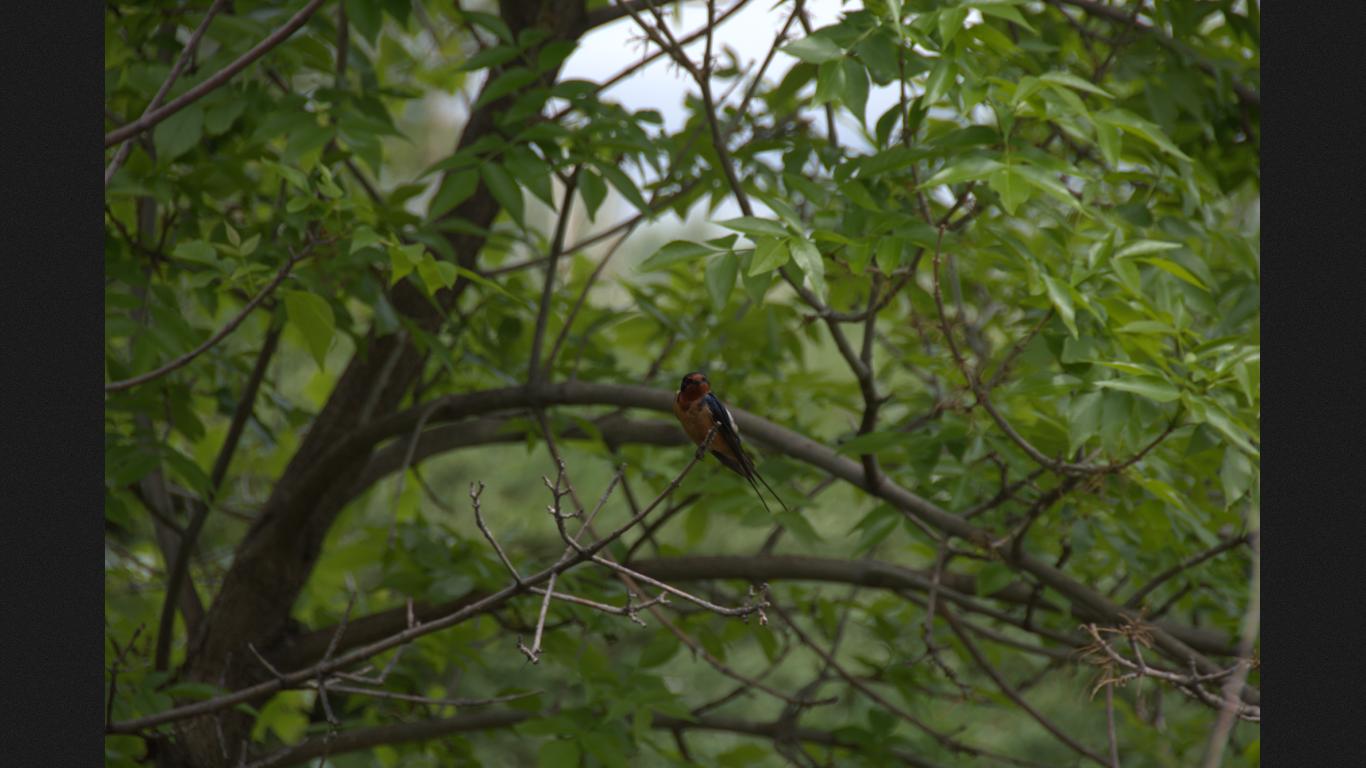
I could walk forward two more steps to improve framing, before I was limited by a creek in front of me,
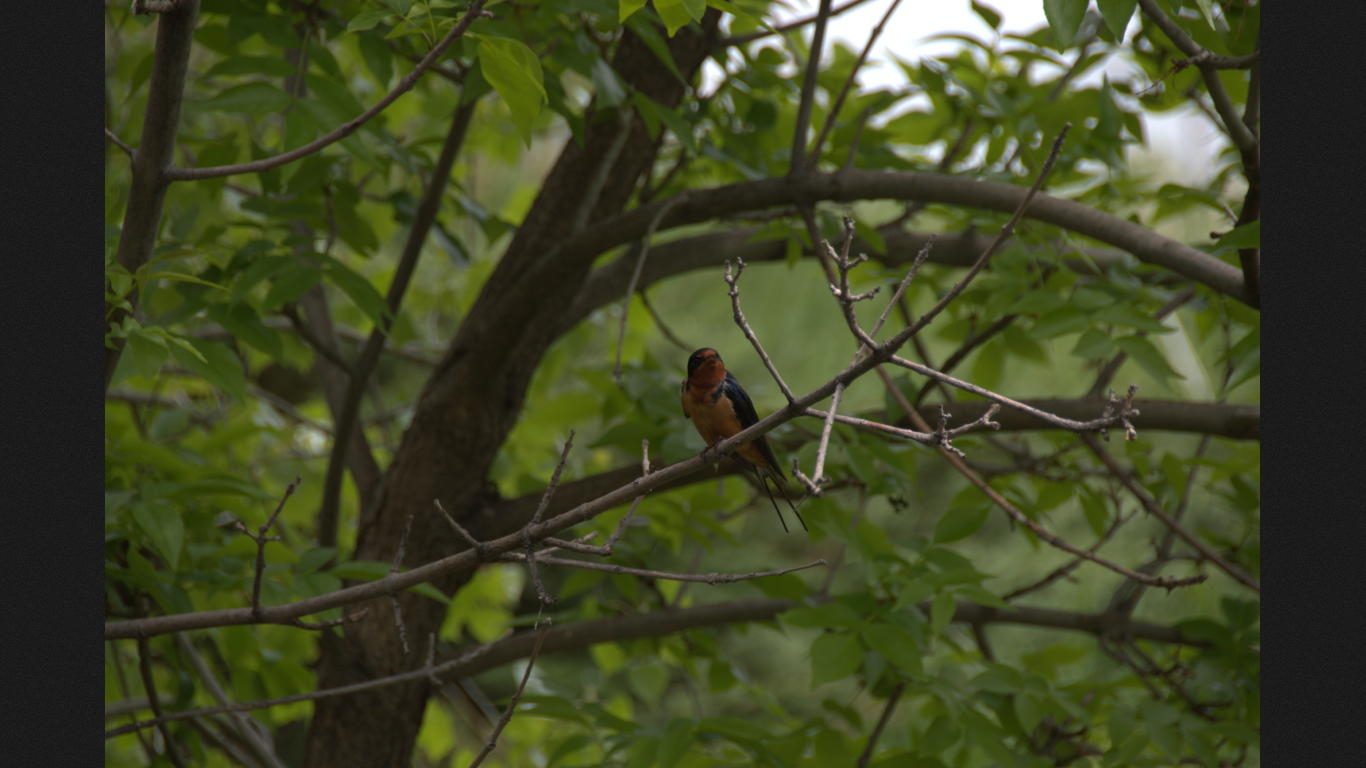
The final shot, illustrating how much I usually crop
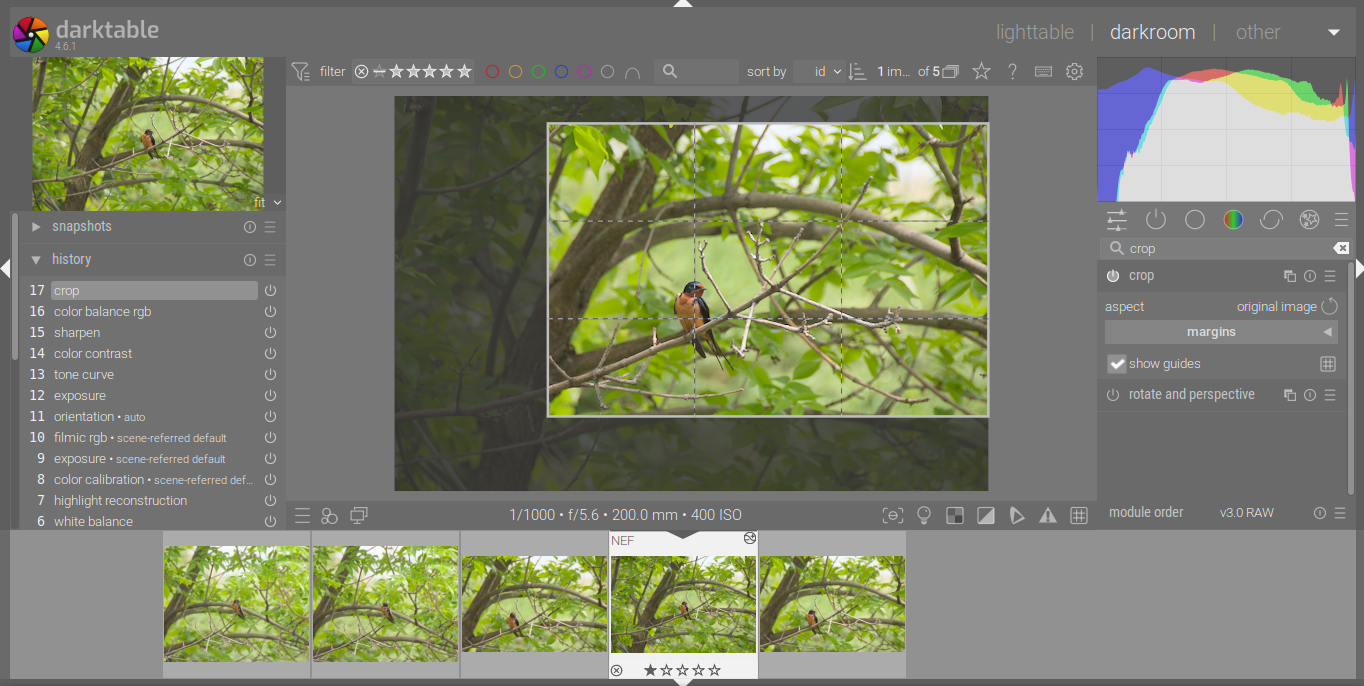
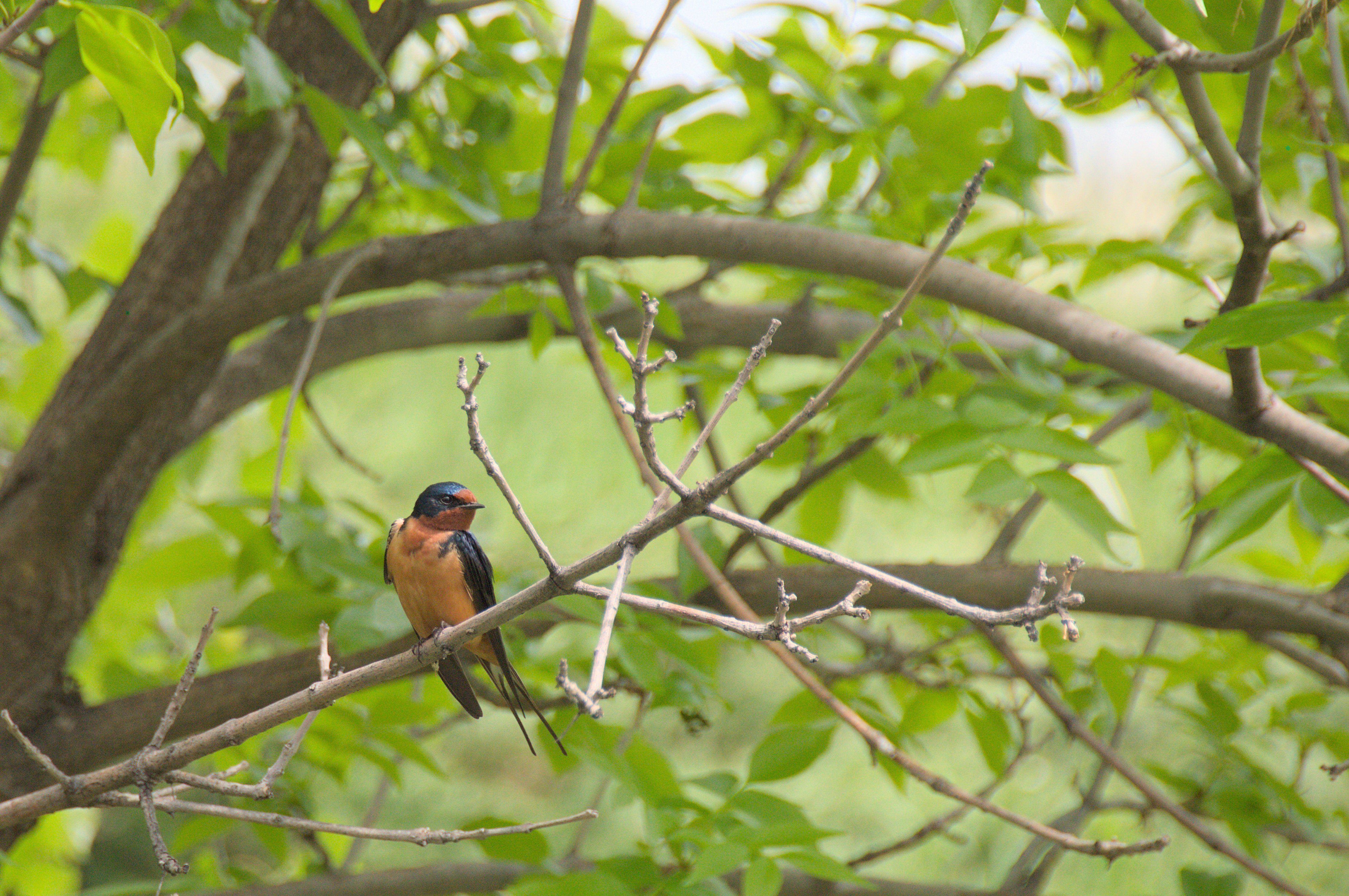
Using the same Barn Swallow location as an example, I know from experience that they perch there if I "come early" and wait standing still for long enough (~15 minutes). So that's what I did when I went there the other day, standing at the same spot, but using the Tamron 150-600mm instead. This time, I didn't have to crop, since I pre-framed my picture, knowing their approximate size and that they would be there sooner or later.
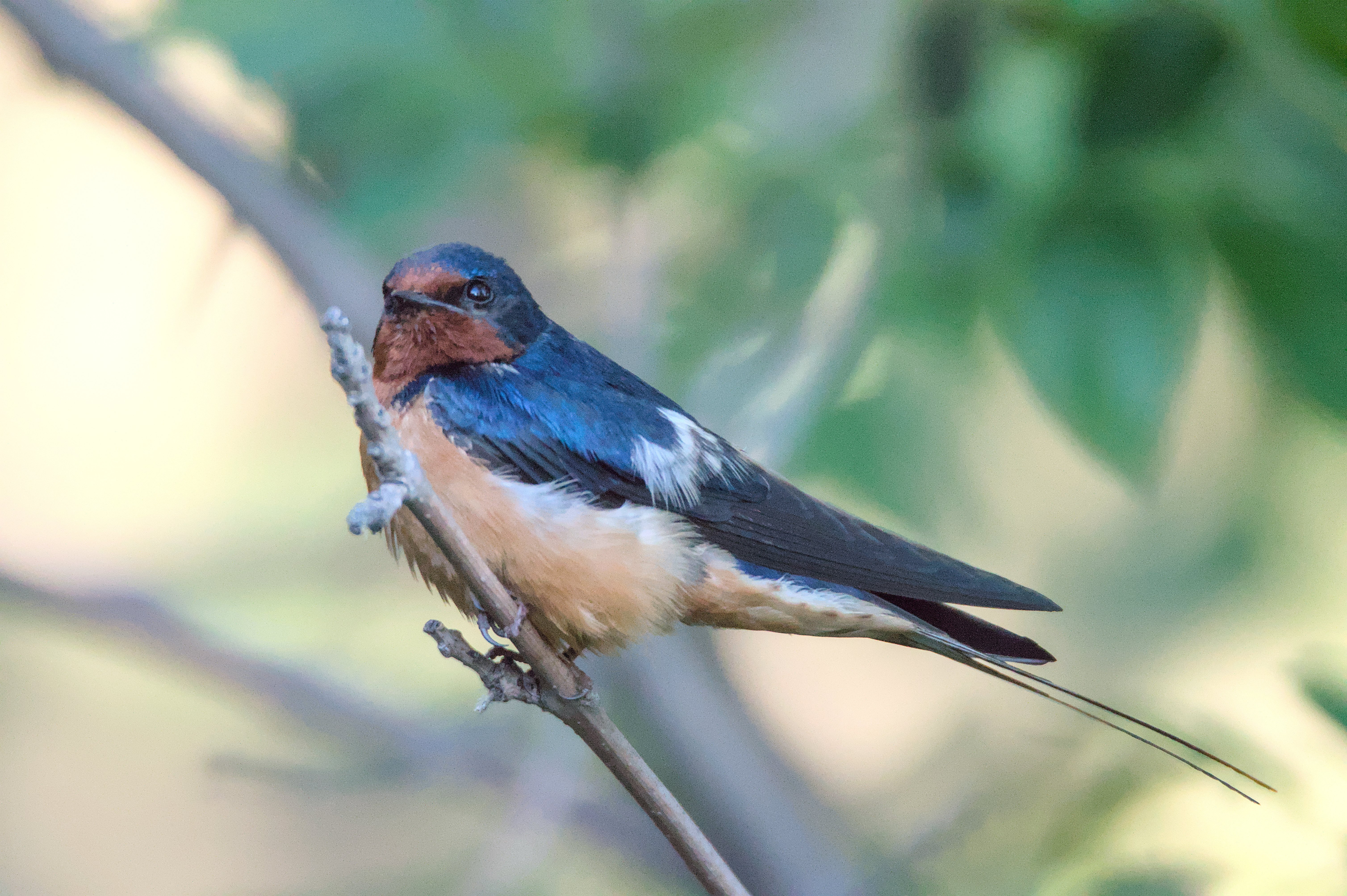
There are situations where you need to crop a bit more, especially for birds that are both small and fast.
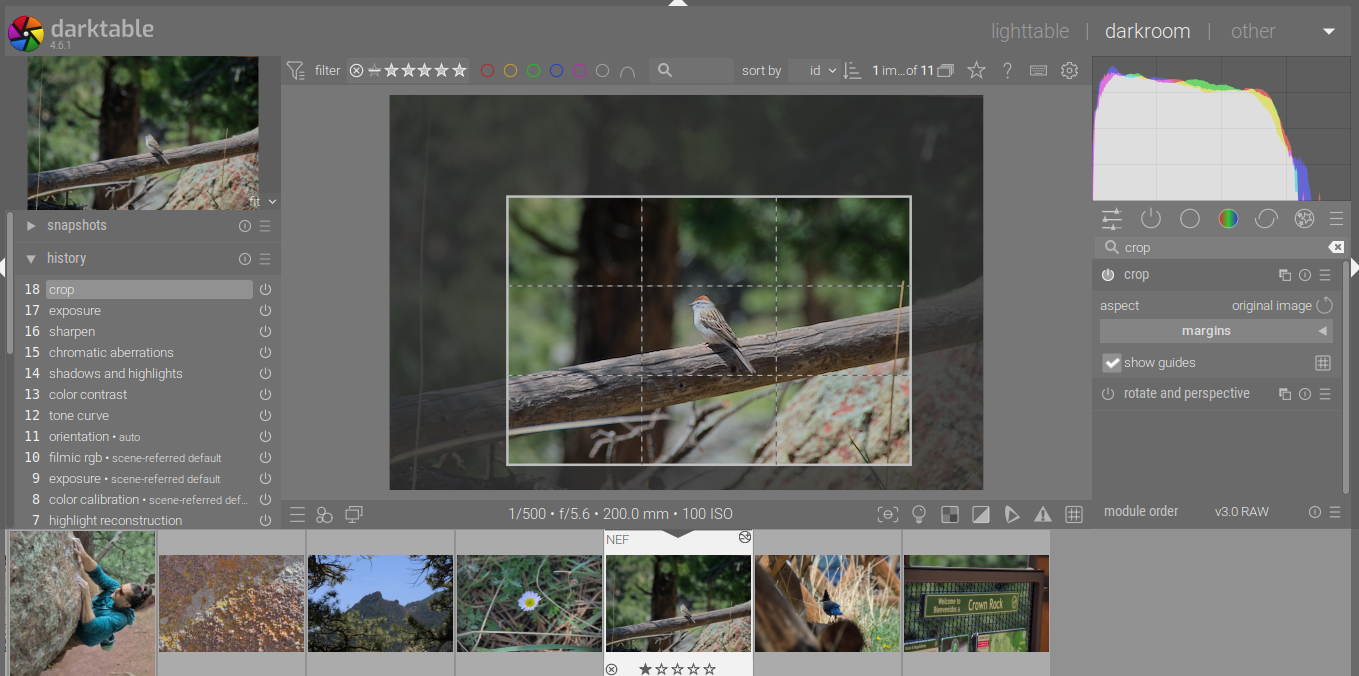
It took me close to 30 minutes to take this photo (D3200 + 18-200mm), since the chipping sparrows were zipping around, so I had to patiently wait for one to be within reach. I took exactly 6 pictures, two steps, lay down on the ground, one shot, two steps, lay down on the ground, one shot, repeat. Until the bird flew away.
I would say 200mm on cropped (300mm full frame equivalent) is when you can start to get good pictures: challenging but doable. 300mm on cropped is fairly nice (450mm equivalent). I don't think there are crazy improvements from 450mm--600mm, since 450mm is already nice for larger birds like jays or blackbirds, and ~500mm may be too short to reliably capture some smaller songbirds. 800mm or so is the longest I've tried and IMO it would be very challenging to have good enough technique to pull it off beyond that.
Of course, a person with a high-resolution, low-light beast will be able to crop more aggressively than I do. Especially if they just post their pictures online, where basically anything at 2MP or so will do.
Oh yes! Here they can be really shy when they're not in the mood, but on chatty days, oh boy, they will be caw, caw, caw, caw staring at you the whole afternoon.


Yes, they beat the red-winged blackbirds this time.
Seen yesterday in Boulder, CO, USA.
Ha, so you're implying my kids are going to grow up to be fertile adults with all the microplastics out there
Of course I like them. They are nice pictures!
I've actually just arrived from my trip to the camera store and I was amazed by how small those lenses are. I was expecting the M43 lenses to be rather small, but not that tiny! I can totally see how a full setup with a couple of lenses would fit in a small camera bag/insert.
Exposure bracketing is indeed something I wish I had. I assume I would use it all the time, because my snow and skies are blown out fairly often.
I think the wifi control is cool as well. I can do the same thing with my gopro and I love it. I can place the camera somewhere and just comfortably walk away and shoot from wherever I am!
The G9 looked appealing online, but after seeing it in-person today, I felt like the body looked to big compared to what I originally had in mind. I kind of want something pocketable when I'm not carrying a backpack with me. I don't think I would mind hiking with it, though. We do similar distances and elevation gains, and I also use the capture clip and I have nothing to complain about it. But for day-to-day stuff, I might prefer something smaller.
I will definitely look into Panasonic cameras with the similar features but a smaller form factor, like the GX9. Thank you again for making yourself available and your willingness to help me!
I actually had the opportunity to check it out in-person today! It is a fantastic camera, impressive build quality and ergonomics. Buttons feel great and the image quality delivers. I feel like Sony is a great system because you go from compact, cropped rangefinder-style to amazing image quality, full frame SLR-style seamlessly. For now, I would prefer to stick to something smaller than the A7iii/iv, though. I was pretty pleased with the A6400. I am currently considering a model from the A6x00 (which I can later upgrade to an A7) or a mid-range M43.
Thanks for the input! I am considering the A6400 and A7iii, given the amazing reviews they always get.
I don't own many expensive Nikon lenses, but I am planning on selling the more expensive stuff that I have to switch systems. That shouldn't really be a problem, since I got quotes from MPB and KEH that I'm happy with.
Sadly, you are spot on regarding micro four thirds and the path they are taking. If I'm not mistaken, Panasonic's last compact micro four thirds camera was the GX-9, released in 2018. Olympus' bodies are not smaller than other brands, either. Some of them even dwarf high-end, full frame DSLR bodies (e.g. E-M1X vs D750), while most are only slightly smaller than full frame mirrorless (e.g. E-M5iii vs A7iii). But honestly, something that bugs me a lot is exactly the situation that you were describing about your trip to Yellowstone. I live pretty close to the Rocky Mountain NP, so I'm there somewhat frequently. I must say, there were situations where I regret not bringing a long telephoto with me, and I own a nice one. I have a huge Tamron 150-600, but I can't hike with it on top of all the outdoor gear I'm bringing, so I only use it when I'm not walking that much.
Olympus, for instance, sells the 75-300 lens which is ridiculously small for the reach you can get. Especially if you compare that to a Nikon F cropped plus 80-400 or full frame plus the 150-600, the difference in size is jarring. At the moment, the only equivalent solution I see for Sony is a cropped body with the new Tamron 70-300, which is comparable in size to the E-M5iii plus the 75-300. Which isn't bad at all. I suspect this would be an image quality vs reach battle, where I could see either winning.
I also agree that micro four thirds is sadly becoming pricier and pricier. In contrast, the market for Sony cropped seems to be always hot.
Actually, I'll see if my local store will have Sony and Olympus bodies in stock so I can try them out some time this week. I've only ever handled a Sony ZV-E10 camera, I'm curious to see how the A6x00 series feels.
I'm checking out your pictures and they do look great and sharp to me. It's great to know that you don't think it is a large camera to carry around with extra lenses, because the image quality is indeed amazing.
I would actually like to ask you a couple of things, if you don't mind. How often do you use high-res modes, and does it work well? If you shoot video, How do you feel about focus tracking? Are there any other "advanced features" that you feel like have been a game changer, like perhaps focus stacking?
I almost got a Sony A6000 two months ago for that reason, to "try it out" and "review it" as a day-to-day camera. As you said, it is nice because you can progressively upgrade within the same system without having to switch entirely. I will follow the advice below and go to my local shop to hold one more recent Sony in my hands, given that they all have the same format as older models anyway.
Thank you again for the tip! Yeah, specs can be read online and they are just numbers I can look up if needed. If they aren't really that physically different, I would be interested to see how those cameras actually feel, since I've personally only tried out Nikon, Canon, and Sony.
That's actually a great tip! I was wondering if a trip to the store would be useful or not, because I'll likely be buying an used and discontinued body. But I guess I can at least see how the different brands look and feel in person.
I know this topic has been discussed a lot before, but in my opinion there is no simple answer to this question.
Lately, I have been a bit disappointed with my Nikon DSLR kit (D3200) and thus I've been considering an upgrade. I got it many years ago, and it is undoubtedly a great, affordable camera that produces great images. I've had lots of fun with it and I can't complain about its performance when shooting -- given ideal conditions. When I am shooting more challenging subjects, however, I feel a bit hindered by my camera body/system. The points that bother me the most are:
- Size. The D3200 is a very nice, compact, and lightweight DSLR, but it is still relatively big compared to modern cameras. It won't fit in a jacket pocket even without an attached lens. More current cameras with a higher image quality can be smaller than it is (but heavier). The situation is even worse for higher-end DSLRs.
- Autofocus. Again, the D3200 is a fantastic camera if you are just using the center focus spot using the optical viewfinder and nothing else. Live view (contrast) focus is straight up unusable, and there are only 11 (phase) focus points or so if using the viewfinder. At least that's the case with "ordinary" Nikon lenses. I don't know how it performs with higher-end lenses, like the Sigma Art line.
- "Low light" performance. I can't bump the ISO significantly before image degradation becomes obvious. Low light in quotes because that's the case even in fairly well-lit situations. Occasionally, I like to print on medium-sized paper (A3+), and if I need anything above ISO 400 to properly expose the image, it won't look that good printed. Of course, I can always stick to printing bright images large and save the "low light" scenes to smaller prints, so this isn't really my main concern.
- Custom controls. I wish I could customize the camera settings a bit more. For example, on my camera, the back button AF/AE can be set to lock the AF/AE or as a back button focus. But in image preview mode, the same button "locks" the image so it can't be deleted. Thus, you need to quit image preview before using that button to trigger autofocus again. I would like to have a dedicated AF button so I can shoot straight from image preview if the opportunity arises. Another example of customization I can't do: settings like auto-ISO and shutter speed can't be capped/limited to a certain range. Let's say I want to use auto-ISO but prevent it from going above 400 to avoid too much noise (and decrease shutter speed but risk shaky images). Or the opposite: prevent the shutter speed in aperture priority mode from going below 1/100 to avoid shaky images and then change ISO instead. Well, I can't do either at the moment. Again, a nice feature to have, but totally something I can live with.
From what I have seen, cameras nowadays have gotten pretty good and they do look like a significant upgrade from 10-15 year old bodies. I guess all popular, entry-level, modern cameras (2019-) solve at least 3 of the 4 problems I listed above, so I don't think I can go wrong with any big brand. However, I'm having a hard time deciding with so many options and sensor size/formats available. My options so far are:
- Nikon Z. Since I am already familiar with Nikon F lenses, I have read a lot about them and I know the strengths and weaknesses of many of those. That means I likely won't be disappointed if I switch to another system, and I want a certain lens that doesn't exist, or the optical performance is poor, or it is prohibitively expensive. The Z50, Z5, and Z6 all look amazing, and I can pick or switch between a full frame or cropped sensor easier than I would if I was stuck with a micro four thirds. They are more affordable than Sony.
- Sony. They seem to be fantastic cameras, with great image quality and features. Sigma and Tamron options for Nikon are likely available for Sony as well. I'm just slightly afraid that lenses might be too expensive for what they offer. Their cameras look super compact and pocketable, which is a huge plus to me. Full frame (A7iii) or cropped (A6400) are also both available for a seamless transition.
- Olympus. I think it is impossible to beat micro four thirds in size and affordability. It is perhaps the only system where you can get a wide angle, portrait, fast prime, macro, and telephoto that you can take everywhere in a small bag while not costing you a fortune. They also have pretty nice features, such as the "live mode"/"smartphone photography", where you can get a frame that was captured slightly before the shutter button was pressed. This must be so cool for wildlife. Olympus stabilization is also highly regarded, with people claiming it to be "gimbal-like". The E-M5 iii looks very appealing. My main concern is that I've never used a micro four thirds before and thus I don't know how much I'm letting go in image quality. I already feel that the dynamic range I get with the D3200 rocking a larger, cropped sensor could be better.
I am not considering:
- Canon. I completely disagree with their "no third party lenses" policy. To me, that is unacceptable.
- Fujifilm. There are barely any telephoto options and they are one of my favorite lens types to use.
- Panasonic. I like what I read about the Lumix cameras, but they seem to be behind Olympus regarding micro four third still-focused cameras (apart from the G9). And I don't know much about the L-mount.
- Hasselblad, Leica, etc. Too expensive. I want something that I can take with me everywhere and not worry too much if it gets damaged.
I would appreciate if you all could help me figure this out! Especially people who have used more than one modern mirrorless system or have recently transitioned from DSLR to mirrorless. Many thanks in advance!
Edited to add:
I forgot to describe how exactly I use my camera. I mostly shoot:
- "Lifestyle" photos, like something cool I've seen while biking to work, walking in the park, visiting museums, etc.
- Hiking, biking, backpacking photos, like landscape, close ups, macro, wildlife, etc.
- Birds of all sizes.
- Occasionally, street photography if there's some cool event going on.
- I do like to shoot video, so something that would be 4K capable would be great.
That is true. I’m glad that here there are people who look after our ecosystem.
But I like to think that in most cases where hikers disturb the environment, it is due to ignorance. I don’t think most people realize how fragile some habitats are and what is or isn’t okay to do, that’s why signs and barricades and whatnot are important.
Ha, that's so cool!
It makes sense, this was close to a creek and the area is significantly fire-prone. I am sure that the recovery after a wildfire would be way harder if people were to have free access to such a sensitive habitat.


It's incredible to me that those microscopic creatures can assemble into such colorful and beautiful patterns! Seen today while hiking.


I was photographing the flowers when this cute little fellow landed there and made the scene a thousand times better!
That's neat! The first peak you can see from right to left is Bear Peak, in Boulder. If you look more to the left from the top of Mt Morrison, you'll be able to see Apache, Kiowa, and North Arapahoe peaks, which can be seen from where I was.
To be fair, they are very common birds in many places!


More photos on pixelfed!
https://pxlmo.com/i/web/post/710716844312163942


I love red-winged blackbirds, but I was hoping to see something else as well today (not Canada Geese and American Robins). I actually photographed an osprey fishing too, but damn, those birds are fast!
Shot today in Boulder, CO, USA
More pics on pixelfed!
https://pxlmo.com/i/web/post/710716844312163942


What a beautiful creature! I always love when I cross paths with a snapping turtle.
More pics from today on pixelfed!
https://pxlmo.com/i/web/post/710716844312163942
I recently bought a used Canon Pixma Pro 100 and I was trying to get it to run on Linux, given that it's the only computer OS I've been using since forever.
From what I've seen, there are no official drivers for the printer and gutenprint doesn't support it. There is an alternative, called Turboprint, which is a paid proprietary software for Linux that seems to fully support the printer.
Well, I would never settle for a proprietary software solution, even though I wouldn't mind the least paying for software if it was FOSS.
A solution is clearly within reach, since others have done it. I am just wondering how hard it would be, and what would be the steps that I could take to come up with a solution. I've done some reverse engineering before, so I know it can range from straightforward to arduous and time consuming. I wonder if this would be too complicated and if I would be better off setting up a QEMU Windows virtual machine with the drivers (that is what I've tried and it works well) while I work on finding a proper solution. I'm now trying to extract the useful part of the MacOS drivers and see if it would work using CUPS. (this part was edited from the original post to address an originally inconsistent phrasing).
I would really appreciate if you could help me with this!
Below I have some further context, some background and references:
1- A post on the Canon community forum says that: >Unfortunately the "Pro" series of printers aren't supported, but if you don't mind paying a little money then check out Turboprint for Linux.
2- The printer doesn't seem to be supported by generic drivers, according to an Arch forum user
4- Dpreview users unanimously say the solution is either Turboprint or Windows VM, according to this post and this other post
5- A printerknowledge user links a post that seems to contain instructions on how to get the printer working on Linux, but it appears to be a dead link
Update 1: I found this link on stack exchange explaining how to extract ppd from dmg MacOS images. I extracted the ppd file and all the resources from the official MacOS driver provided by Canon. Now I need to replace MacOS-specific paths to something valid on Linux. There are three or so entries that I need to configure. I will update this post as I make some progress on adapting the drivers to Linux.







